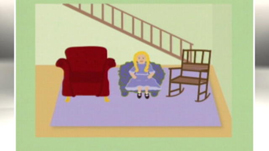Teachers' Domain - Digital Media for the Classroom and Professional Development
User: Preview



Señora Alicia reviews the events of the story of Ricitos de Oro y Los Tres Osos to introduce plot- primero (first) the three bears go for a walk, después (after) Ricitos de Oro tests the small chair and she liked it a lot, entonces (then) she ate the soup from the small bowl, entonces (then) Ricitos de Oro fell asleep on the small bed, and al final (at the end) Ricitos de Oro woke up and saw the three bears and ran away.
This video was adapted from ¡Arte y más!, originally produced by KET as a complete curriculum for primary-level Spanish based on arts and humanities content. Spanish teachers can use these resources in traditional or online instruction to reinforce language acquisition and teach about Latin American culture.
Los Tres Osos Coloring Page (Document)
Plot (first, after, then, finally)
Familiar stories make wonderful teaching resources. One of the best stories to demonstrate plot sequence and structure is Goldilocks and the Three Bears . Students can learn the words that explain how a story unfolds in the proper sequence and make the plot clear. By learning temporal words such as first, after, then, and finally in the context of a story, students learn how to signal sequence and closure.
The Spanish version of this familiar story not only provides an opportunity for cross-cultural connections, it’s an entry into the rich world of narrative story-telling in Latin America. Some of the most well-known examples of Latin American literature use a style called “magical realism.” Perhaps the most well-known Latin American novelist in this style is Gabriel García Márquez (born 1927) who won the Nobel Prize in literature. His works include One Hundred Years of Solitude and Love in the Time of Cholera . Many writers have followed his style, including Isabel Allende (born 1942) in The House of the Spirits , and Laura Esquivel (born 1950) in Like Water for Chocolate.
Magical realism is often confused with surrealism, but there is a difference. Surrealism is a dream-like view of an alternate reality. Magical realism is set in the real everyday world in which people live. However, it also accepts that the real world holds mysteries and unexplained events that can make it a very magical place. Ghosts, premonitions, or similar events are accepted as normal and a part of life in magical realism. Native Latin American cultures expected the realm of the spirits to be a part of the everyday world. Fairy tales, like Goldilocks are very similar. The reader does not question why bears live in a house like humans or wonder how they speak. These facts are accepted as normal in the story, and this is similar to magical realism. They are accepted as simply part of the magical everyday world we live in.
Teaching Tips
Activity: Goldilocks pantomime
Vocabulary
primero, después, luego, al final
For this activity, you will need:
• the story of Goldilocks
Directions
 Loading Standards
Loading Standards